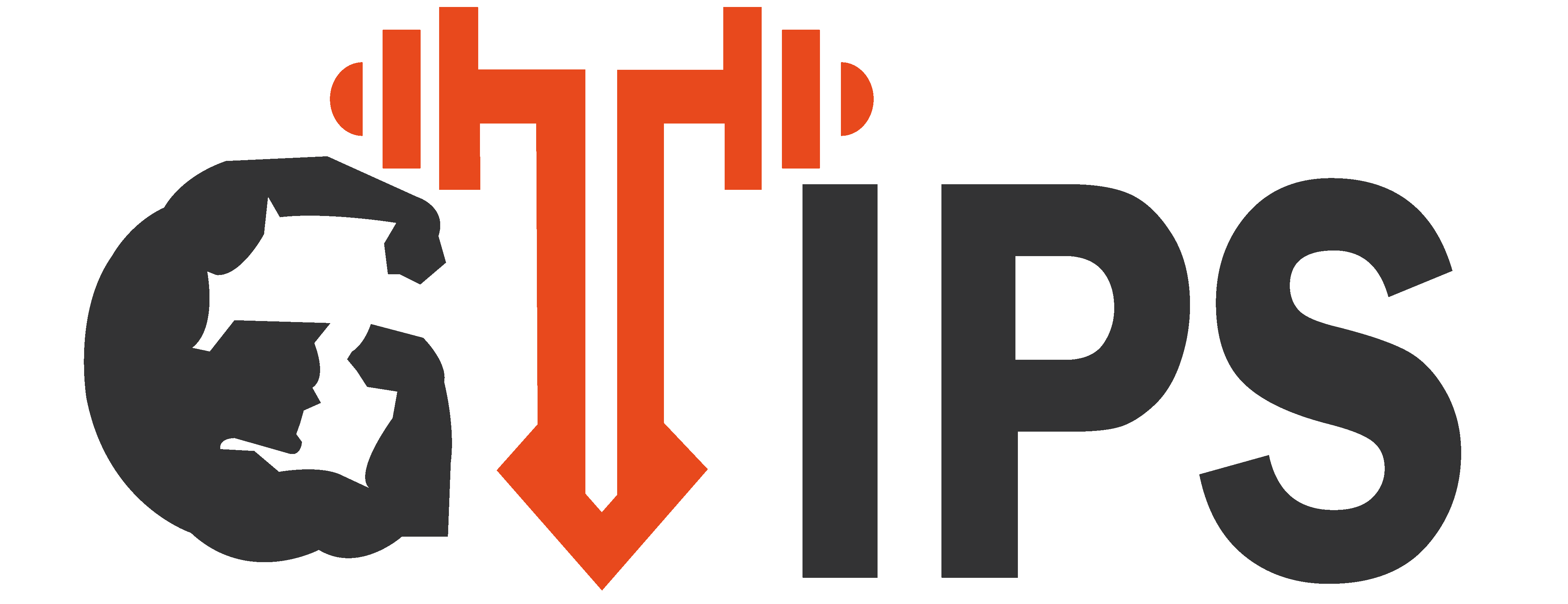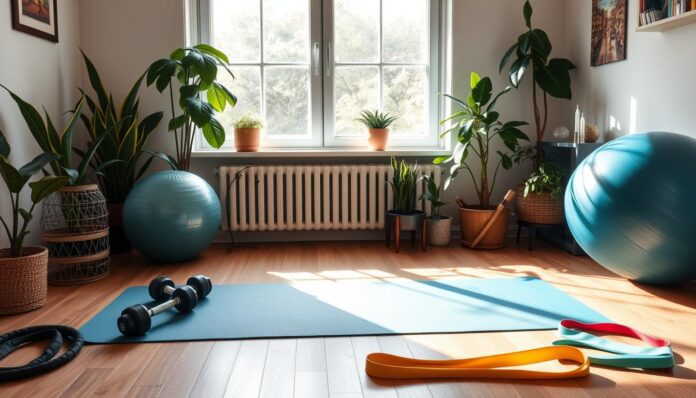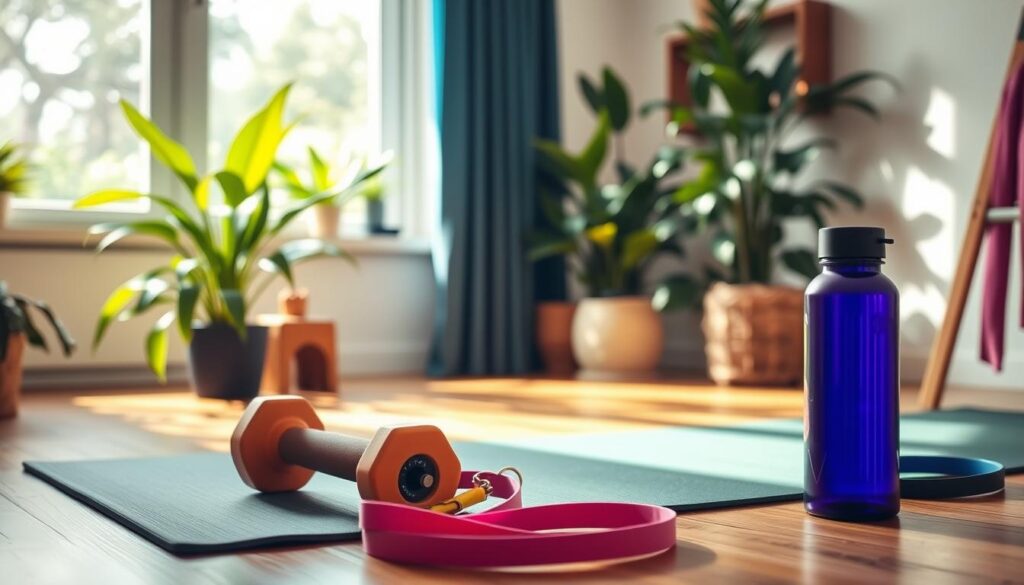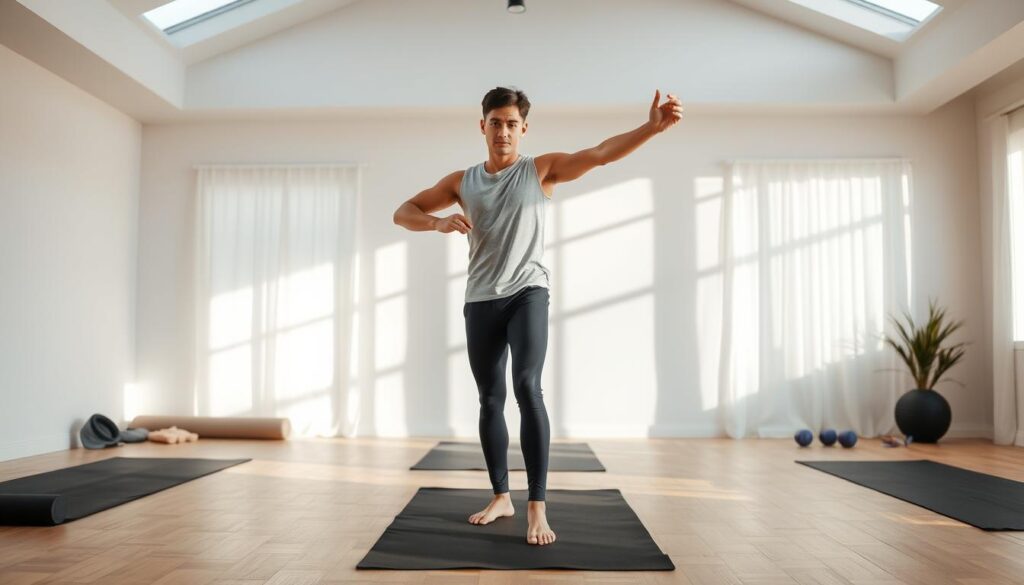Are you ready to start a fitness journey from home? Starting a workout routine can seem tough, but our home workouts make it easy. You can do bodyweight exercises and reach your fitness goals without expensive gym memberships or special equipment.
Key Takeaways
- Home workouts are effective for beginners with no equipment required
- Bodyweight exercises like squats, push-ups, and lunges form the foundation
- Start with 2-4 workouts per week, allowing 48 hours between sessions for recovery
- Warm-up before exercising to prepare muscles and elevate heart rate
- A basic routine includes bodyweight squats, push-ups, walking lunges, and more
Understanding Home Workouts: Benefits and Fundamentals
Home workouts are a great option for those starting out in fitness. They are easy on the wallet and offer privacy. These exercises can be as good as gym workouts if done right and regularly.
They help strengthen muscles, improve flexibility, and boost heart health. This is because they focus on major muscle groups.
One big plus of home workouts is how easy they are to start. You don’t need expensive gym memberships or special equipment. Simple exercises like squats, pushups, and planks can be done with your body or a few household items. This makes them perfect for those wanting to start a fitness routine without spending a lot.
Being consistent is key with home workouts. Just a few minutes each day can make a big difference in your fitness. They can help you lose weight, get stronger, or just feel better overall.
To get the most out of home workouts, focus on doing them right. Doing exercises wrong can limit their benefits and even hurt you. Knowing how to do each exercise and keeping your body in the right position is important.
In short, home workouts are a smart choice for those wanting to get fit and reach their health goals. They offer convenience, are budget-friendly, and can be tailored to your needs. This makes them a great way to start a fitness journey from home.
“Strength training may help in reducing body fat and increasing lean muscle mass, according to the Mayo Clinic.”
Using resistance bands or light dumbbells can be very effective in home workouts. Research shows that resistance bands can work as well as free weights or machines. This makes them a great, affordable choice for home fitness.
Also, exercises like lunges, squats, planks, and pushups are great for building strength. They don’t need any extra equipment, just an exercise mat. Mixing these with resistance training can give you a well-rounded workout that works many muscle groups.
Essential Warm-Up Routine for Beginners
Getting your body ready for a workout is key to avoiding injuries and doing your best. A good warm-up takes about 5 minutes. It includes dynamic stretches, joint exercises, and light cardio. These steps warm up your warm-up exercises, boost blood flow, and get your nervous system ready for the pre-workout routine.
Dynamic Stretching Exercises
Dynamic stretches like arm swings, leg swings, and trunk rotations get your joints moving and warm up your beginner stretches. They stretch your muscles and boost your range of motion. Do each stretch for 15-30 reps to get your body ready for harder exercises.
Joint Mobility Movements
- Shoulder circles
- Neck rolls
- Ankle circles
- Hip rotations
Joint mobility exercises increase flexibility and lower injury risk by improving range of motion.
Light Cardio Options
- Marching in place
- Jumping jacks
- Brisk walking
Adding 2-3 minutes of light cardio, like marching or jumping jacks, raises your heart rate. It prepares your body for the workout ahead.
“Proper warm-up enables muscles and joints to achieve maximum flexibility, leading to proper form during exercises and minimizing injury risks.”
The length and intensity of your warm-up might change with the weather or where you work out. In colder places or seasons, you might need a longer warm-up. Pay attention to how your body feels and adjust your warm-up as needed for a safe and effective routine.
Best Home Workouts for Beginners
Starting your fitness journey is exciting and rewarding. It’s great to begin with simple home workouts. These exercises help you build a strong foundation for a healthier life. You can work out in your own space, making it easier to reach your goals.
A basic circuit routine is a great workout for beginners. Begin with dynamic stretches and light cardio to warm up. Then, do a circuit that includes:
- 20 bodyweight squats
- 10 push-ups (or modified knee push-ups)
- 10 walking lunges per leg
- 10 dumbbell rows (using a household item like a milk jug)
- 15-second plank hold
- 30 jumping jacks
Do 2-3 rounds of this circuit, resting a bit between each round. As you get better, you can do more rounds or add harder exercises. Try burpees, mountain climbers, or box jumps too.
| Exercise | Reps | Sets |
|---|---|---|
| Bodyweight Squats | 20 | 3 |
| Push-Ups (or Knee Push-Ups) | 10 | 3 |
| Walking Lunges | 10 per leg | 3 |
| Dumbbell Rows | 10 | 3 |
| Plank Hold | 15 seconds | 3 |
| Jumping Jacks | 30 | 3 |
Always focus on proper form and technique. This makes your workouts more effective and safer. As you get stronger, increase the intensity and time of your workouts. Remember to drink plenty of water and eat well to support your home workout routines and beginner exercises.
“Consistency is more important than any specific program. Start with just 5 minutes a day and build from there.”
Proper Form and Technique Guidelines
Keeping the right exercise form is key to getting the most out of your workouts and staying injury-free. Bad technique can cause muscle imbalances, joint pain, and more. Let’s look at common mistakes, safety tips, and how to fix your form to reach your fitness goals safely and well.
Common Exercise Mistakes
- Rounding the back during squats or deadlifts
- Flaring elbows in push-ups or bench presses
- Overarching the spine in plank or abdominal exercises
- Swinging weights instead of controlling the movement
- Locking out joints during resistance training
Safety Precautions
To stay safe while working out, start with simpler versions and slowly add more challenge as you get better. Move smoothly and listen to your body. Don’t ignore pain or discomfort, as it can cause harm.
Form Correction Tips
Use mirrors or videos to check your form and spot what needs work. Focus on doing the exercise right, not just lifting heavy or doing lots of reps. Move slowly, use your core, and keep your body straight to master the exercise.
Mastering the right exercise form and technique will not only make your workouts safer but also more effective. Remember, being consistent and patient is essential for lasting fitness success.
Bodyweight Exercise Fundamentals
Bodyweight exercises are great for beginners. They help build strength, improve balance, and boost fitness. You can do them anywhere, making them perfect for home workouts.
These exercises are very adaptable. You can start with easier versions and get harder as you get stronger. For example, you can begin with wall push-ups and move to regular push-ups.
Bodyweight exercises are excellent for getting stronger. They work many muscles at once. This helps you build a balanced and strong body.
| Bodyweight Exercise | Beginner Sets/Reps | Intermediate Sets/Reps | Advanced Sets/Reps |
|---|---|---|---|
| Push-Up | 3 sets of 12-15 reps | 3 sets of 15-20 reps | 3 sets of 20-25 reps |
| Bodyweight Squat | 3 sets of 10-12 reps | 3 sets of 12-15 reps | 3 sets of 15-20 reps |
| Plank | 3 sets of 30 seconds | 3 sets of 45 seconds | 3 sets of 60 seconds |
Adding bodyweight exercises to your routine can change your fitness game. Start with the basics and increase the challenge as you get better. This way, you’ll get the most out of these effective workouts.
“Bodyweight exercises are the foundation of functional fitness, helping to build strength, stability, and balance in a simple yet effective way.”
Creating Your Workout Space at Home
Setting up a home gym is easier than you think. You can create a great workout space with just a little space. Focus on the basics that help you reach your fitness goals without spending too much.
Space Requirements
A 6×6 feet area is enough for most beginner exercises. It lets you move freely for bodyweight routines, yoga, and light weights. You can use any space in your home, like a room, corner, or garage section.
Essential Equipment Options
Start with a few key pieces of equipment. A yoga mat makes floor exercises comfy. Resistance bands add a challenge and are easy to store. A sturdy chair or bench is great for exercises like tricep dips or step-ups.
Later, you might want adjustable dumbbells or a pull-up bar. These tools let you do more exercises without buying lots of equipment.
Safety Considerations
Make your home gym setup safe by clearing obstacles and using good flooring. Proper lighting is also key to avoid accidents. This way, you can focus on your fitness without worries.
Start with the basics and add more as you grow. Keep your space safe and free from distractions. This way, you can enjoy working out at home.
Progressive Workout Programs
Starting your fitness journey means using progressive workout plans that push your body harder. These plans get tougher as you go, helping your muscles grow stronger. Begin with simple routines and then add more reps, sets, or time as you get stronger.
To keep improving, add harder exercises as your strength grows. For instance, move from knee push-ups to regular push-ups and then decline push-ups. Try to make your workout plan harder every 2-4 weeks to keep your body challenged and growing.
It’s important to track your progress to stay motivated and adjust your workouts. Watch how many reps you can do, the weights you lift, and how long your workouts are. This helps you see where you need to get better and keeps you on track with your fitness goals.
| Week | Training Days | Reps | Sets | Body Part Split |
|---|---|---|---|---|
| 1 | 3 days | 8-12 | 9 sets | Full-body |
| 2 | 4 days | 15 | 16 sets (large bodyparts), 12 sets (smaller bodyparts) | Upper body/Lower body |
| 3 | 6 days | 15 | 16 sets (large bodyparts), 12 sets (smaller bodyparts) | Push/Pull/Legs |
| 4 | 4 days | 15 | Increased sets to ensure muscle overload and growth | Full-body |
Using progressive workout programs helps you challenge your body, build strength, and reach your fitness goals. Always remember, staying consistent and dedicated is the key to reaching your full fitness level.
“The secret of getting ahead is getting started. The secret of getting started is breaking your complex overwhelming tasks into small manageable tasks, and then starting on the first one.” – Mark Twain
Nutrition Support for Home Training
Proper nutrition is key for your home workouts. It helps you reach your fitness goals. We’ll look at pre-workout carbs, post-workout recovery, and staying hydrated.
Pre-workout Nutrition
Before working out, eat carbs that are easy to digest. This gives your body the energy it needs. Have a snack or small meal 1-2 hours before, with 25-50 grams of carbs.
Good choices include a banana with peanut butter, whole grain toast with honey, or Greek yogurt with berries.
Post-workout Recovery
After working out, your body needs protein and carbs. This helps repair muscles and replenish energy. Aim for a meal or shake with 20-30 grams of protein and 30-60 grams of carbs.
Try grilled chicken and sweet potato, or a protein shake with fruit and Greek yogurt.
Hydration Guidelines
Staying hydrated is vital for health and exercise. Drink water before, during, and after workouts. Aim to drink half your body weight in ounces of water daily.
If you weigh 150 pounds, drink at least 75 ounces of water a day.
| Nutrient | Recommended Intake |
|---|---|
| Protein (post-workout) | 0.14-0.23 grams per pound of body weight |
| Carbohydrates (pre-workout) | 25-50 grams |
| Water (daily) | Half your body weight in ounces |
Remember, good workout nutrition, fitness diet, and hydration for exercise are key. They help you train harder, recover faster, and reach your fitness goals.
Tracking Progress and Setting Goals
Keeping track of your fitness journey is key to staying motivated. Use a workout journal or fitness app to log your exercises and progress. Also, take body measurements and photos every month to see how you’ve changed.
When setting goals, use the SMART method: Specific, Measurable, Achievable, Relevant, and Time-bound. For instance, aim to do 10 full push-ups in one set in 8 weeks. Update your goals often to keep yourself challenged and on track.
- Use a fitness tracking tool, such as a workout journal or app, to record your exercises, reps, sets, and perceived difficulty.
- Take monthly body measurements and progress photos to visually track your physical changes.
- Set SMART goals that are Specific, Measurable, Achievable, Relevant, and Time-bound.
- Continuously review and adjust your fitness goals based on your progress to stay motivated and challenged.
“Tracking your fitness journey is the key to unlocking your full fitness journey. It’s not just about the numbers, but the sense of accomplishment and motivation that comes with seeing your hard work pay off.” – John Doe, Certified Fitness Trainer
By tracking your workout journal and setting realistic goals, you’ll stay on top of your fitness. This approach will help you reach your fitness goals. See how your hard work changes your body and mind.
Common Challenges and Solutions
Starting a fitness journey is exciting, but it comes with challenges. You might face lack of motivation, time constraints, and plateaus. But, with the right mindset and strategies, you can beat these obstacles and stay fit.
To stay motivated, treat your workouts like scheduled appointments. Make your fitness routine a priority and schedule it in your calendar. When time is tight, try shorter, high-intensity workouts. They can be done in 10-20 minutes and are very effective.
To avoid plateaus, vary your workout routine. Change the exercises, intensity, and types of workouts. This keeps your muscles challenged and makes fitness exciting again.
Struggling with workout motivation? Get a virtual workout buddy or join an online fitness community. The support and camaraderie can motivate you. Also, set up a reward system for your fitness wins. Treat yourself to something nice to keep you motivated.
Consistency is key to fitness success. Even a few minutes of activity each day can lead to big progress. By facing challenges and finding solutions, you’ll reach your fitness goals and live a healthy, active life.
| Common Fitness Challenges | Effective Solutions |
|---|---|
| Lack of Motivation |
|
| Time Constraints |
|
| Workout Plateaus |
|
If you’re experiencing persistent pain or discomfort during workouts, see a healthcare professional. It’s important for your safety and well-being.
“Consistency is the key to long-term fitness success. Even small steps can lead to significant progress over time.”
Conclusion
Your home fitness journey is an exciting path to better health and wellness. As a beginner, you’ve found the convenience and effectiveness of home workouts. They offer an easy way to start your fitness transformation. Consistency, proper form, and gradual progression are key to your success.
Remember, every workout counts, and small steps lead to significant improvements over time. Combine your regular exercise routine with balanced nutrition and adequate rest to optimize your results. Stay committed, track your progress, and adjust your workout plan as needed to achieve your fitness goals.
With dedication and a positive mindset, you can make remarkable strides in your home fitness journey. Embrace the flexibility and efficiency of working out at home. Let it empower you to take control of your health and wellness. Your future self will thank you for the investment you’re making today.
FAQ
Are home workouts effective for beginners starting their fitness journey?
Yes, home workouts are great for beginners. They need no equipment and can be done in small spaces. Squats, push-ups, lunges, and planks are key exercises for a beginner’s routine.
How often should a beginner do home workouts?
Beginners should aim for 2-4 home workouts a week. Make sure to have 48 hours off in between for recovery.
What are the benefits of home workouts?
Home workouts are convenient, affordable, and private. They help beginners build strength, improve flexibility, and boost heart health.
What should a beginner’s home workout routine include?
A beginner’s routine should include squats, push-ups, lunges, dumbbell rows, planks, and jumping jacks.
How important is proper warm-up for home workouts?
A good warm-up is essential, lasting about 5 minutes. It includes dynamic stretches, joint exercises, and light cardio. This gets your muscles ready and prevents injuries.
What are some beginner-friendly home workout examples?
Try circuits of bodyweight exercises like 20 squats, 10 push-ups, and 10 walking lunges per leg. Also, do 10 dumbbell rows, 15-second planks, and 30 jumping jacks.
Why is proper form important for home workouts?
Proper form is key for effective workouts and to avoid injuries. Common mistakes include rounding the back in squats, flaring elbows in push-ups, and arching the spine in planks.
What are the key bodyweight exercises for home workouts?
Key exercises include squats, push-ups, lunges, planks, and burpees. These exercises help build strength, improve balance, and increase flexibility.
What equipment is needed for a home workout space?
You’ll need a yoga mat, resistance bands, and a sturdy chair. Dumbbells or a pull-up bar are optional but not necessary for beginners.
How can a beginner progress their home workout program?
Start with a basic routine and gradually increase the difficulty. Add more reps, sets, or try harder exercises as you get stronger.
How important is nutrition for supporting home training efforts?
Good nutrition is vital for home workouts. Eat carbs before working out for energy. After, eat protein and carbs to help muscles recover and replenish energy.
How can a beginner track progress and set goals for home workouts?
Use a workout journal or app to track your exercises and progress. Take body measurements and photos monthly. Set specific, measurable, achievable, relevant, and time-bound goals.
What are some common challenges with home workouts and how can they be overcome?
Challenges include lack of motivation, time, and plateaus. Schedule workouts, use short, intense workouts, and change your routine to beat plateaus. For motivation, try workout buddies, rewards, or fitness challenges.






